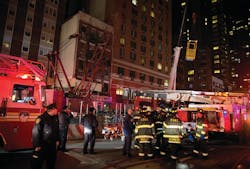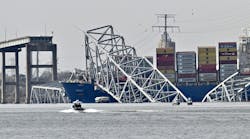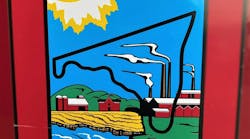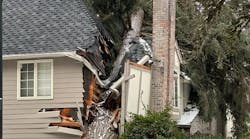New York City has one of the oldest subway systems in the world. By miles of track and numbers of stations, it is the world’s largest. But even at that, the mass transit needs of the city are greater still.
The need for another subway line in Manhattan has been debated for years. The specific idea and planning for a Second Avenue subway has been in the works since 1929. After a number of starts and stops, the tunneling began again in 2007. The actual methods of construction vary, depending on the section being worked on. The primary method is the tried-and-true “cut-and-cover” method, where the street is cut open and a deep trench is dug. The tunnel is then constructed before an overhead support system is added. Once that is completed, the trench is refilled and the surface is reinstated. Another construction method is the use of the Tunnel Boring Machine, a nearly 500-ton machine that can bore through 50 feet of bedrock in a day.
This work is both difficult and dangerous. The vast size and scope of the operation requires the solution to a number of logistical problems including lighting, air handling, debris removal, equipment maintenance, sanitation and worker safety. By comparison, in the huge project to build Water Tunnel 3 (work began in 1970), 23 workers have been killed on the job. The Second Avenue subway construction amazingly has had no fatalities dating back to work that began in 1929. But there have been close calls.
The Incident
On Tuesday evening, March 19, 2013, a 27-year old construction worker named Joseph Barone was working at the subway construction site at Second Avenue and East 95th Street in Manhattan. Barone a member of Local 731, the excavators union more commonly known as “sandhogs,” was walking by a piece of machinery when his pants leg caught on the edge. This sudden pulling caused the slightest stumble and the man soon found his foot off the temporary wooden flooring and sinking into mud.
Other construction workers tried to free the man for several minutes with no success. At 8:33 P.M., the fire department was notified and a “confined-space rescue” alarm was dispatched for Manhattan Box 1233, Second Avenue and East 95th Street. This alarm matrix would send two engines, two ladders, Rescue 1, two squad companies and the Hazardous Materials unit, Battalion 10, and the Special Operations Battalion.
The incoming FDNY units would be faced with a construction worker, trapped in mud, 75 feet below street level in a wide trench excavation dug for the subway extension. The nighttime conditions were frigid and damp and the clay-like mud would prove to be an obstacle not easily overcome.
The first-due truck, Ladder 43, sized up the situation and quickly took a basic, but vital action. The firefighters made their way to the trapped man, attached a life-saving rope to him and slung it up and over a high point to prevent his sinking any farther into the mud. (Life-saving ropes are 150-foot-long, 15/16-inch nylon 707 continuous filament in a three-strand, left-lay configuration. The 10-pound rope has a breaking strength of 9,000 pounds and is carried by every unit in the FDNY).
Shortly after these actions were taken, Rescue 1 arrived and was directed by Battalion 10 to the 96th Street and Second Avenue entrance. The members quickly sized-up the problem and assembled a cache of tools they believed would be needed in the trench below. The sandhog was stuck in the mud up to his waist and members of Rescue 1 and Squad 41 began to dig around the worker with hand tools. They soon found that working in this type of wet, clay-like mud (known as “Bull’s Liver”; see sidebar on page XX) was like “moving in wet cement.”
Rescue 1 began using a construction company air knife, but it was having little effect due to low air pressure. Despite the slow progress, the rescuers continued. After an hour of messy, dogged work, it was determined that the man’s leg was also pinned underneath sheets of plywood, now covered by the wet mud. The mud caused a tremendous suction effect on these submerged sheets of wood and their removal would prove to be both difficult and time consuming.
As additional technical rescue help was called to the scene, several 36-volt Sawzalls were brought down and attempts to cut the plywood proved futile as the wet clay slowed the cutting and gummed up the saws. A grip hoist was placed in position and using a J-hook, members tried to pull or lift the plywood. The suction power of the wet clay could not be overcome and the hook eventually broke off small pieces of the wood. (This would eventually prove to be the way to remove the plywood – small piece after small piece.)
Battalion Chief Donald Hayde from Special Operations Command (SOC) arrived and was placed in direct charge rescue efforts directly in the trench. The 36-year veteran took in the scene around him: his firefighters were faced with sheets of wood covered by a cold, slippery slurry of wet clay-like mud that was acting like quicksand and almost impossible to move due to the suction. Rescuers were getting stuck left and right as they used hand tools to dig in the immediate area, Stanley pumps were being operated in a dewatering effort and the grip hoist was being set and reset, pulling away sections of the embedded plywood. With the operation taking longer than expected, it was decided to have a rescue-trained paramedic enter the trench and evaluate the worker’s condition.
An FDNY paramedic moved in and evaluated his patient’s condition. The worker was actually in remarkable condition, except for the cold. The paramedic was able to run an IV and after the worker’s torso was completely cleared, warm blankets were applied to stabilize his temperature. As part of his assessment the paramedic found out the worker was a Dallas Cowboys football fan. This initiated an ongoing “friendly” dialogue from the care-giving New York Giants fan. An EMS doctor also examined the trapped worker and monitored his vitals.
subhead
On the street above, three rescue companies and three squad companies had joined in the effort, along with several other specialized units. The SOC Air Compressor Unit was positioned and supplied the correct pressure to the SOC air knife. Three sump pumps were in operation. The Con Edison vacuum truck was positioned and despite the great distance was able to remove some of the mud and water. The first grip hoist became clogged with mud and was placed out of service. A second grip hoist was repositioned with a better directional pull and this operation continued. Various SOC members rotated in and out of digging positions, trying to keep fresh hands at work.
A heavy equipment operator joined in and following the directions of the rescue leader dug a trench adjacent to the trapped worker to help drain the soil. After three hours of backbreaking trial and error, and learning how to overcome the extreme difficulties of the mud slurry, the rescuers were finally making good headway. When enough plywood was peeled away and digging by hand exposed the worker’s leg, a Prusik cord was girthed around his leg just above the knee and the final removal of the entrapped leg was accomplished.
The worker was medically re-evaluated, then secured in a Stokes basket and hoisted toward the street in a construction basket, where a wave of camera flashes ignited and live news cameras caught the action. On both sides of Second Avenue, crowds of construction workers, neighborhood residents and other interested New Yorkers broke into cheers when a muddy, but conscious Joseph Barone emerged relatively uninjured and was rolled to a waiting ambulance.
More than 130 firefighters and other rescue workers were needed to accomplish this very unusual four-hour long rescue. Several firefighters were injured and were also taken to the hospital with minor injuries. The FDNY SOC returned several days later to confer with the construction company representatives and engineers. Large samples of the mud were taken to the FDNY SOC Technical Rescue School at Randall’s Island for testing and evaluation. They hope to find the better methods of dealing with this dangerous “mud” in any future rescue operations.






